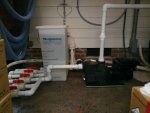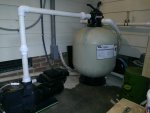Motor / Impeller mismatch?
Split by moderator from sticky HERE. Please ask questions in your own thread. Thanks, jblizzle
New Question.................Why is performance poorer after upgrading from a 1 HP impeller to a 2.5 HP impeller?
I just upgraded my 2-speed Hayward SuperPump to a variable speed motor.
The original motor was an A.O. Smith 1.5 HP with a 1 HP impeller. (Inherited from previous owner/installer, who is a pool builder.) The nominal rating on the motor was 1.5 NPHP x 1.3 Service Factor = 1.95 THP. At low speed the motor was plate-rated at 1/4 HP and ran at 1725 RPM. At high speed it ran at 3450 RPM.
While researching this upgrade I determined that the Hayward SuperPump VS uses the standard SuperPump body (with 1.5" connections), a 1.5 NPHP x 1.0 Service Factor = 1.5 THP variable speed motor and a 2.5 HP impeller. The SuperPump VS motor can run at 600 RPM to 3000 RPM.
My new EcoTech variable speed motor is rated at 1.5 NPHP x 1.6 Service Factor = 2.4 THP. It can run at 1035 RPM (30%) to 3450 RPM (100%).
Since the Hayward SuperPump VS uses a 2.5 HP impeller, and since my motor was more robust that the SuperPump VS motor, as part of my upgrade I upgraded my impeller to a 2.5 HP impeller (along with the corresponding diffuser and seal plate). This literally gave me a "roll your own" SuperPump VS with a more powerful motor.
(I just read through Hydraulics 101, where there is the statement "Total HP (THP)...... = NPHP * Service Factor. This is the maximum load that can be safely driven by the motor and must always be greater than the maximum load from the impeller. A motor can be driven above the THP but will likely fail in a short period of time." How does Hayward get away with a 1.5 THP motor with a 2.5 HP impeller? More importantly, is my 2.4 motor at any risk from being used with a 2.5 HP impeller?)
In my "winter" configuration (with the heat pump bypassed), I was able to run the original motor (with its 1 HP impeller) at low speed (1725 RPM). I was able to get approximately 20 GPM, 5-7 lbs. of pressure at the Tagelus TA-60 sand (Zeolite) filter and 2.5-3.0 (out of 5) on the flowmeter for the Liquidator. (Note-The bottom range of the system flowmeter is 20 GPM.)
With the new motor and 2.5 HP impeller I was able to get approximately 20 GPM and 4 lbs. of pressure with the motor running at 40%/1380 RPM and approximately 25 GPM and 5-7 lbs. of pressure running at 50%/1725 RPM.
The Liquidator was not functioning, however, with the motor running at 40%/1380 RPM or 50%/1725 RPM. I determined that there was not enough pressure to push any flow past the check valve on the input (fill) side of the Liquidator. After removing the check valve it turned out that at 40%/1380 RPM there still wasn't enough pressure (or head) to reach the Liquidator. (I.e. with the tubing disconnected from the Liquidator, if the end of the tubing was held several inches below the connector on the Liquidator there would be flow but at the level of the connector there would not be any flow.) Increasing the motor speed to 50%/1725 RPM, the same speed as the original motor (with its 1 HP impeller), would provide flow to the Liquidator (but only with the check valve removed).
The location of the pool equipment might be a factor in this disappointing performance. The equipment pad is roughly 40 feet away from the closest skimmer and roughly 3-4 feet above the level of the pool.
All piping is 1.5". There are three 1.5" lines from two skimmers and the bottom drain that come together just in front of the pump. The Tagelus TA-60 is plumbed for 1.5" pipes. There is a 1.5" return (that splits underground to two eyeballs) and a 1.5" line to a waterfall.
What can I do to get performance at least as good as the old system? With the upgrade from the 1 HP impeller to the 2.5 HP impeller I really expected to be able to run at a lower speed. As it stands now, it looks like I'll have to run at a higher speed. Would there be any value in downgrading to a 1.5 HP or 1.0 HP impeller?
(I realize that most of my savings from the variable speed motor will - hopefully - come during summer when I can - hopefully - run at less than full speed with the additional 60 feet of piping and the heat pump in-circuit. My experience so far has me nervous, however.)
In case they might be useful, I've included a few pictures of the equipment pad.







